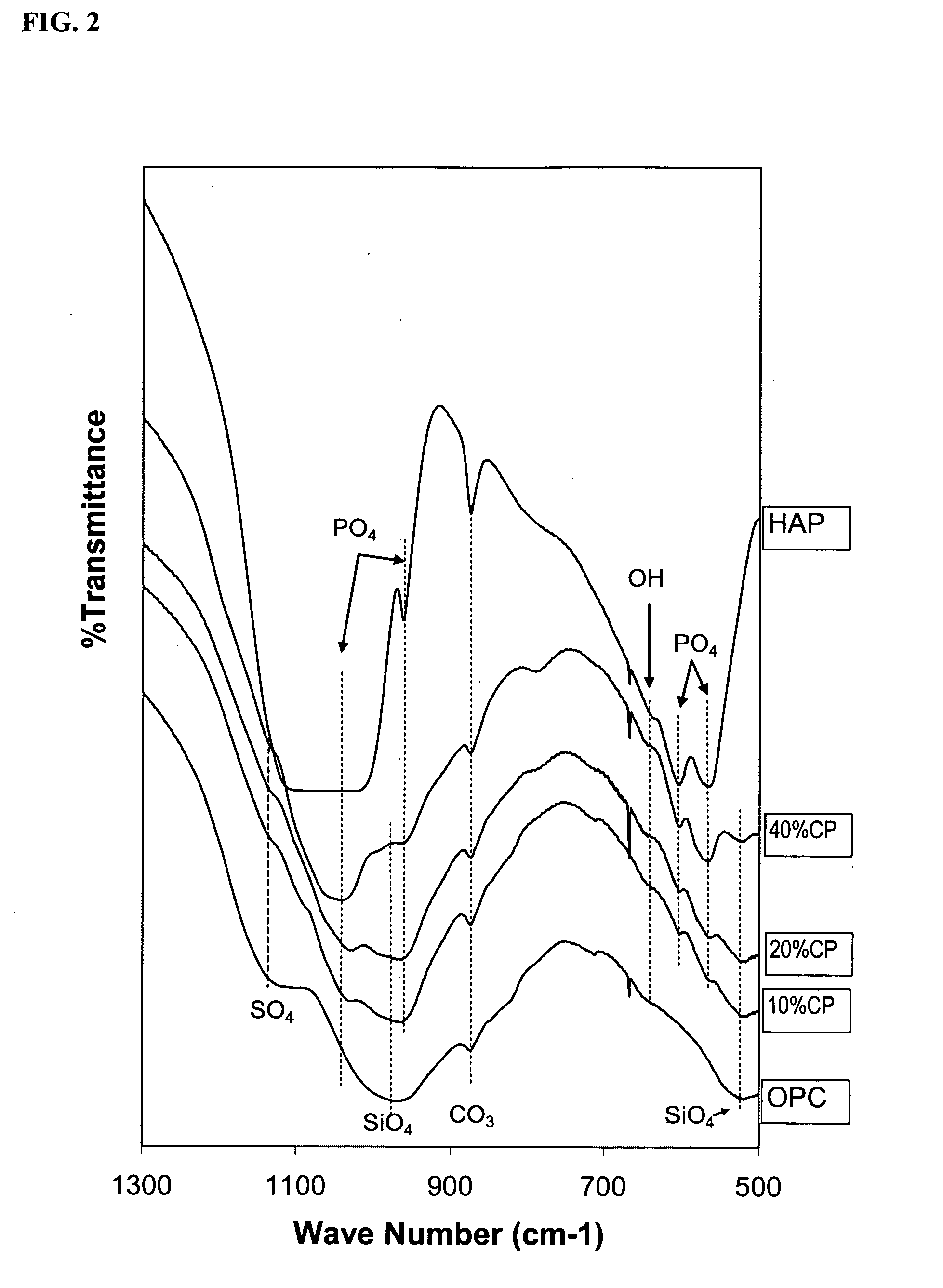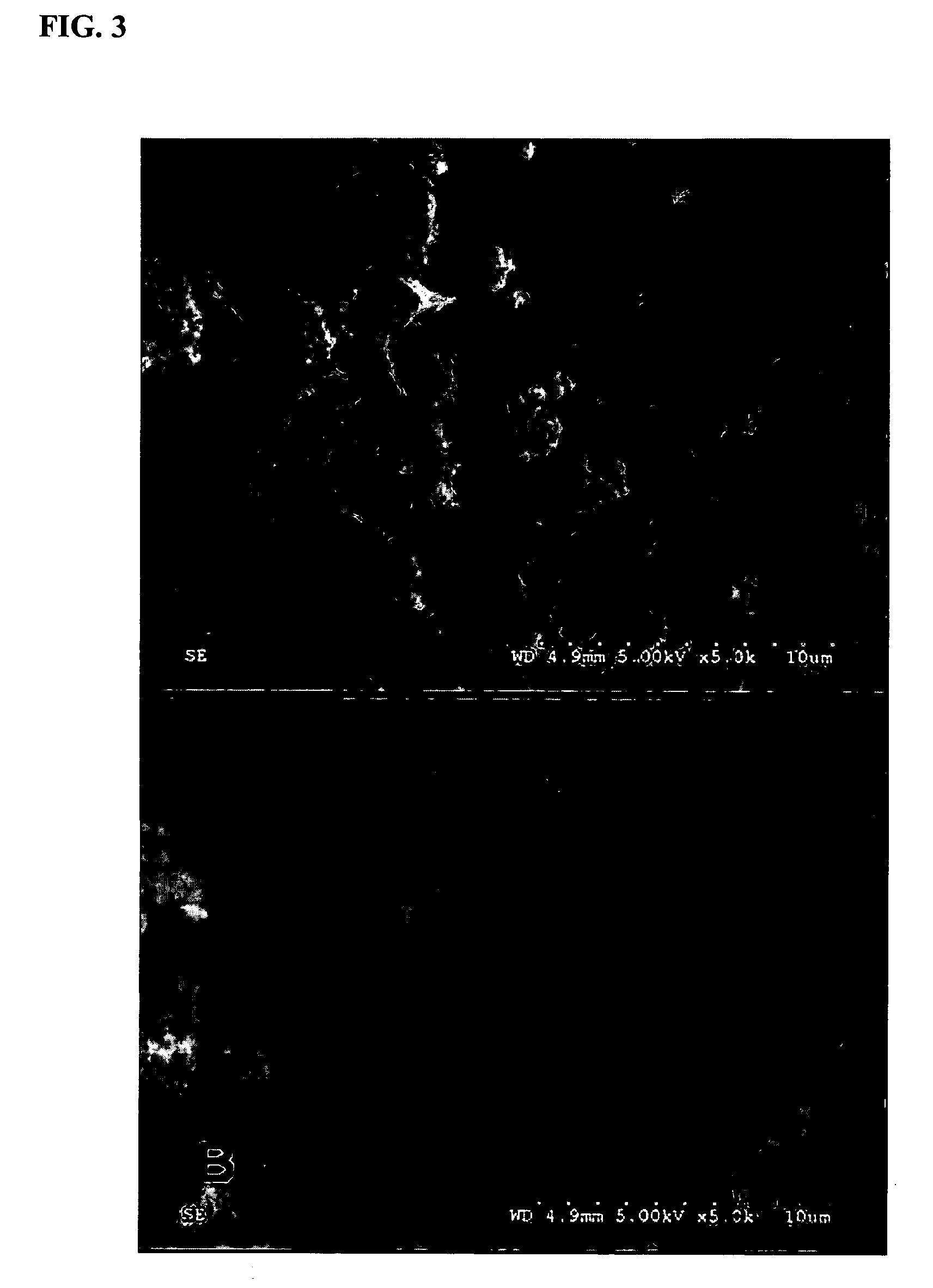Hydraulic cement compositions and methods of making and using the same
a technology of hydraulic cement and composition, applied in the field of high-strength hydraulic cement composition, can solve the problems of affecting the quality of concrete, many aspects of their chemistry have yet to be fully understood, and significantly increasing durability and strength, so as to achieve the effect of significantly improving the compressive strength of portland cemen
- Summary
- Abstract
- Description
- Claims
- Application Information
AI Technical Summary
Benefits of technology
Problems solved by technology
Method used
Image
Examples
example 1
Preparation and Properties of Phosphate Silicate Cement CPSC
[0073] This example used general purpose commercial ordinary Portland type cement OPC (ASTM I) containing approximately 50% C3S, 25% C2S, 12% C3A (tricalcium aluminate 3CaO.Al2O3), 8% C4 AF (tetracalcium aluminoferrite 4CaO.Al2O3.Fe2O3), and 5% calcium oxide CaO. 11 grams of dicalcium phosphate was dried in the furnace at 140° C. for 24 hours and then mixed with 29 grams of the tetracalcium phosphate and with the OPC cement powder (160 grams) in alcohol solution by ball milling for 24 hours. The resulting slurry was spray dried. The average particle size of the cement powder was about 10 um. The setting time of the CPSC cement thus was about 2 hours, for a water / cement ratio of 0.21. The average compressive strength after 7-day incubation at 37° C. and 100% humidity was 104 MPa, with a standard deviation of 7 MPa, (FIG. 1). The X-ray diffraction pattern provided in FIG. 6 indicates that the set cement contained about 15% o...
example 2
Preparation of High Strength CPSC Cement for Orthopedic Applications
[0075] In this example the phosphate silicate cement was prepared synthetically using well defined pure chemicals (as opposed to the poorly defined minerals utilized for preparation of typical commercial Portland cement). The raw materials used for the preparation of CPSC cement were colloidal silica (50 wt % Ludox, from 3M company) for SiO2, calcium hydroxide (99.9%, Sigma-Aldrich) for CaO, tetracalcium phosphate (Ca4(PO4)2O), and dicalcium phosphate anhydrate (CaHPO4.H2O) (Fisher). Alternatively, and with no effect on the final properties of CPSC, the colloidal silica may be derived from thermal decomposition of hydrated silicon alkoxide such as tetra-eth-oxide silicate (TEOS).
[0076] The designed composition of the present cement is 65 wt % tricalcium silicate, 20 wt % dicalcium silicate, 10 wt % tetracalcium phosphate, and 5 wt % dicalcium phosphate. A 200 g batch was prepared by mixing 96.32 g of colloidal sil...
example 3
Preparation of CPSC High Strength Gray and White Cements for Dental Applications
[0078] The following procedure is to prepare a high strength, pure, bioactive, and biocompatible CPSC cement for dental applications. Raw materials used are colloidal silica (50 wt % Ludox, 3M) for SiO2, calcium hydroxide (99.9%, Sigma-Aldrich) for CaO, boehmite (AlOOH) for Al2O3, iron oxide (Fe2O3, 99% Fisher), calcium sulfate dehydrate (CaSO4.H2O, 99%, Fisher), Ca(OH)2, and monocalcium phosphate (Ca(H2PO4)2, 99%, Sigma). Alternatively, and with no effect on the final properties of CPSC, the colloidal silica may be derived from thermal decomposition of hydrated silicon alkoxide such as tetra-eth-oxide silicate (TEOS).
[0079] The designed composition of the cement is 58 wt % tricalcium silicate (3CaO.SiO2), 11 wt % dicalcium silicate (2CaO.SiO2), 6 wt % tricalcium aluminate (3CaO.Al2O3), 7 wt % tetracalcium aluminoferrite (4CaO.Al2O3.Fe2O3), 4 wt % calcium sulfate dehydrate (CaSO4.2H2O), 4 wt % calcium ...
PUM
| Property | Measurement | Unit |
|---|---|---|
| mechanical strength | aaaaa | aaaaa |
| size | aaaaa | aaaaa |
| compressive strength | aaaaa | aaaaa |
Abstract
Description
Claims
Application Information
 Login to View More
Login to View More - R&D
- Intellectual Property
- Life Sciences
- Materials
- Tech Scout
- Unparalleled Data Quality
- Higher Quality Content
- 60% Fewer Hallucinations
Browse by: Latest US Patents, China's latest patents, Technical Efficacy Thesaurus, Application Domain, Technology Topic, Popular Technical Reports.
© 2025 PatSnap. All rights reserved.Legal|Privacy policy|Modern Slavery Act Transparency Statement|Sitemap|About US| Contact US: help@patsnap.com



